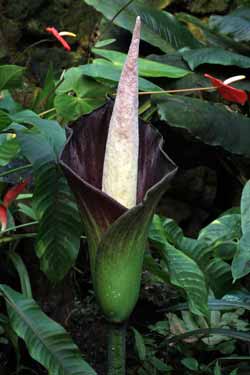Plants mimic scent of pollinating beetles

Amorphophallus hewittii<br>University of Zurich<br>
However, an evolutionary biologist from the University of Zurich has now proved that this is not the case with the arum family at least, which evolved its scent analogously to the pre-existing scents of scarab beetles and thus adapted to the beetles unilaterally. The mutual adaptation between plants and pollinators therefore does not always take place.
Soon, the gardens and fields will be blooming, fragrant and buzzing again. Bees, flies and beetles fly, as they have done for millions of years, from flower to flower in search of food or mates, drawn by flower shapes, colors and the scents of the individual plants. Often, pollinating insects favor certain scents and preferentially visit the flowers in question. Previously, researchers always assumed that floral scents and the fondness of pollinating insects for a specific scent evolved mutually via coevolution of plants and insects. However, the evolutionary biologist Florian Schiestl from the University of Zurich now proves that this was not the case with the arum family and their pollinators.
Scent of the scarab beetle mimicked
Schiestl and a colleague from Bayreuth studied the arum family and one of its pollinators, the scarab beetles. In the beetles, they discovered many scent molecules used for chemical communication that were also found in the plants. Based on a phylogenetic reconstruction, they realized that these scents were already present in the ancestors of today’s scarab beetles. Evidently, these prehistoric scarab beetles already used the same or similar scents back in the Jurassic period to find food or mates. Unlike today’s scarab beetles, these ancestors did not pollinate plants, the first members of the arum family to be pollinated by beetles not appearing until around 40 million years later. “In the course of evolution, the arum family mimicked the scents of scarab beetles to attract pollinating insects more efficiently,” says Schiestl.
Coevolution less common than assumed
In research, coevolution is regarded as a driving force behind the development of a mutual adaptation between two organisms. However, this is not true of the arum family, which developed its scent along the pre-existing communication of scarab beetle scents. “Coevolution between plants and pollinating insects might well be less common than we thought,” Schiestl concludes.
Literature:
Florian P. Schiestl, and Stefan Dötterl. The Evolution of Floral Scent and Olfactory Preferences in Pollinators: Coevolution or Pre-Existing Bias? Evolution. International Journal of Organic Evolution. March 12, 2012. doi: 10.1111/j.1558-5646.20
Contact
Prof. Dr. Florian Schiestl
Institute of Systematic Botany
University of Zurich
Tel. +41 44 634 84 09
E-Mail: florian.schiestl@systbot.uzh.ch
Media Contact
More Information:
http://www.uzh.chAll latest news from the category: Life Sciences and Chemistry
Articles and reports from the Life Sciences and chemistry area deal with applied and basic research into modern biology, chemistry and human medicine.
Valuable information can be found on a range of life sciences fields including bacteriology, biochemistry, bionics, bioinformatics, biophysics, biotechnology, genetics, geobotany, human biology, marine biology, microbiology, molecular biology, cellular biology, zoology, bioinorganic chemistry, microchemistry and environmental chemistry.
Newest articles

Properties of new materials for microchips
… can now be measured well. Reseachers of Delft University of Technology demonstrated measuring performance properties of ultrathin silicon membranes. Making ever smaller and more powerful chips requires new ultrathin…

Floating solar’s potential
… to support sustainable development by addressing climate, water, and energy goals holistically. A new study published this week in Nature Energy raises the potential for floating solar photovoltaics (FPV)…

Skyrmions move at record speeds
… a step towards the computing of the future. An international research team led by scientists from the CNRS1 has discovered that the magnetic nanobubbles2 known as skyrmions can be…





















